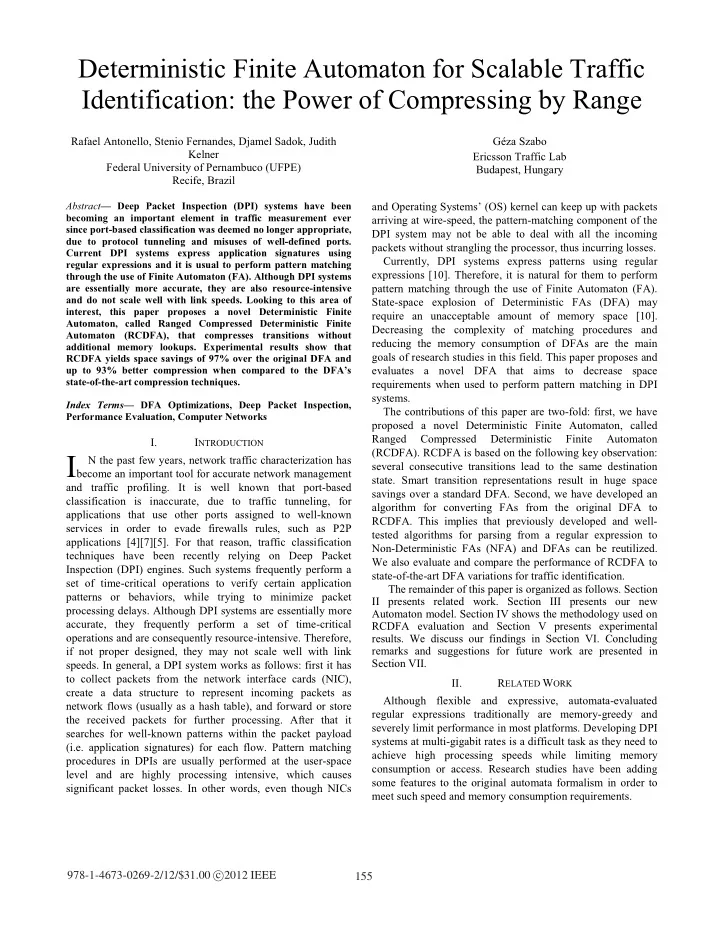

Deterministic Finite Automaton for Scalable Traffic Identification: the Power of Compressing by Range Rafael Antonello, Stenio Fernandes, Djamel Sadok, Judith Géza Szabo Kelner Ericsson Traffic Lab Federal University of Pernambuco (UFPE) Budapest, Hungary Recife, Brazil Abstract — Deep Packet Inspection (DPI) systems have been and Operating Systems’ (OS) kernel can keep up with packets becoming an important element in traffic measurement ever arriving at wire-speed, the pattern-matching component of the since port-based classification was deemed no longer appropriate, DPI system may not be able to deal with all the incoming due to protocol tunneling and misuses of well-defined ports. packets without strangling the processor, thus incurring losses. Current DPI systems express application signatures using Currently, DPI systems express patterns using regular regular expressions and it is usual to perform pattern matching expressions [10]. Therefore, it is natural for them to perform through the use of Finite Automaton (FA). Although DPI systems are essentially more accurate, they are also resource-intensive pattern matching through the use of Finite Automaton (FA). and do not scale well with link speeds. Looking to this area of State-space explosion of Deterministic FAs (DFA) may interest, this paper proposes a novel Deterministic Finite require an unacceptable amount of memory space [10]. Automaton, called Ranged Compressed Deterministic Finite Decreasing the complexity of matching procedures and Automaton (RCDFA), that compresses transitions without reducing the memory consumption of DFAs are the main additional memory lookups. Experimental results show that goals of research studies in this field. This paper proposes and RCDFA yields space savings of 97% over the original DFA and up to 93% better compression when compared to the DFA’s evaluates a novel DFA that aims to decrease space state-of-the-art compression techniques. requirements when used to perform pattern matching in DPI systems. Index Terms — DFA Optimizations, Deep Packet Inspection, The contributions of this paper are two-fold: first, we have Performance Evaluation, Computer Networks proposed a novel Deterministic Finite Automaton, called Ranged Compressed Deterministic Finite Automaton I. I NTRODUCTION (RCDFA). RCDFA is based on the following key observation: I N the past few years, network traffic characterization has several consecutive transitions lead to the same destination become an important tool for accurate network management state. Smart transition representations result in huge space and traffic profiling. It is well known that port-based savings over a standard DFA. Second, we have developed an classification is inaccurate, due to traffic tunneling, for algorithm for converting FAs from the original DFA to applications that use other ports assigned to well-known RCDFA. This implies that previously developed and well- services in order to evade firewalls rules, such as P2P tested algorithms for parsing from a regular expression to applications [4][7][5]. For that reason, traffic classification Non-Deterministic FAs (NFA) and DFAs can be reutilized. techniques have been recently relying on Deep Packet We also evaluate and compare the performance of RCDFA to Inspection (DPI) engines. Such systems frequently perform a state-of-the-art DFA variations for traffic identification. set of time-critical operations to verify certain application The remainder of this paper is organized as follows. Section patterns or behaviors, while trying to minimize packet II presents related work. Section III presents our new processing delays. Although DPI systems are essentially more Automaton model. Section IV shows the methodology used on accurate, they frequently perform a set of time-critical RCDFA evaluation and Section V presents experimental operations and are consequently resource-intensive. Therefore, results. We discuss our findings in Section VI. Concluding remarks and suggestions for future work are presented in if not proper designed, they may not scale well with link Section VII. speeds. In general, a DPI system works as follows: first it has to collect packets from the network interface cards (NIC), II. R ELATED W ORK create a data structure to represent incoming packets as Although flexible and expressive, automata-evaluated network flows (usually as a hash table), and forward or store regular expressions traditionally are memory-greedy and the received packets for further processing. After that it severely limit performance in most platforms. Developing DPI searches for well-known patterns within the packet payload systems at multi-gigabit rates is a difficult task as they need to (i.e. application signatures) for each flow. Pattern matching achieve high processing speeds while limiting memory procedures in DPIs are usually performed at the user-space consumption or access. Research studies have been adding level and are highly processing intensive, which causes some features to the original automata formalism in order to significant packet losses. In other words, even though NICs meet such speed and memory consumption requirements. 978-1-4673-0269-2/12/$31.00 c � 2012 IEEE 155
Recommend
More recommend